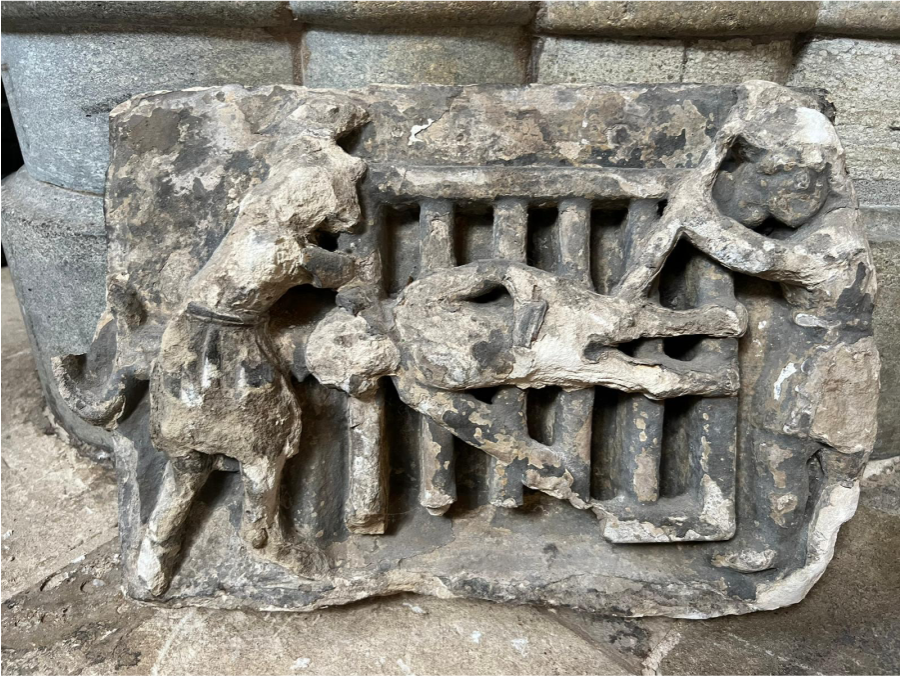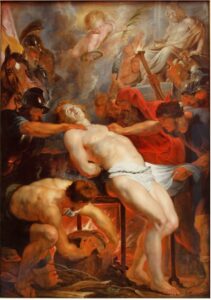 By Canon Ian Morter
By Canon Ian Morter
One of the curiosities in Exeter Cathedral is a carved stone which is displayed in the South Quire Aisle, behind the Bishop’s Throne. It is relatively small and easily passed by without notice. It depicts the martyrdom of St Laurence. The saint is depicted tied to a gridiron, the mode of his martyrdom in AD 258. It was saved when the Church of St Mary Major, that once stood on Cathedral Green, was demolished in 1969. John Allan, the Cathedral Archaeologist, told me that it was preserved from the Medieval Church that was replaced in 1827 and this carving was then built into the wall above the Chancel Porch on the North side of St Mary Major.
The reason for my interest in this piece of mediaeval carving is that 10 August is the day when the Church commemorates St Laurence. Laurence who was born in Huesca in Aragon, and met the future Pope Sixtus II in the city we now call Zaragoza, they travelled back together from Spain to Rome. When in AD 257 Sixtus became Pope he ordained Laurence as a deacon and later appointed him as Archdeacon of Rome. This was the most senior of the seven deacons in the Church. It was an office of great responsibility and trust which included the care of the treasury and riches of the Church therefore he was responsible for the distribution of alms to the poor of the City.
In August AD 258, the Roman Emperor Valerian issued an edict that all bishops, priests, and deacons should immediately be put to death. On 6 August, Pope Sixtus II was captured, while celebrating the liturgy, and was executed. The Prefect of Rome demanded that Lawrence hand over the riches of the Church, we are told that Lawrence asked for three days to gather the wealth. He worked swiftly to distribute as much Church property to the poor and needy to prevent it from being seized by the Prefect. On the third day, leading a small procession, Laurence, presented himself to the Prefect. When ordered to deliver the treasures of the Church, he presented the city’s poor, crippled, blind, and suffering, and declared that these were the true treasures of the Church: “Here are the treasures of the Church. You see, the church is truly rich, far richer than your emperor!”
The Prefect was so angry that Lawrence was sentenced to death and imprisoned, where he baptized fellow prisoners. He was martyred by the Prefect, who had a great gridiron prepared with hot coals beneath it and had Lawrence placed upon it, hence Lawrence is usually depicted with the gridiron. During the martyr he suffered great pain for a long time, and the legend concludes, he cheerfully declared: “I’m well done on this side. Turn me over!” He was buried in the Catacombe of Cyriaca on the Via Tiburtina, just outside Rome. As with many early church martyrs, St Laurence witness to Jesus put his life at risk which he and other Christians were willing to do as disciples of Christ their Lord and Saviour.
 This is the painting of the Martyrdom of St Laurence (1614) by the Flemish painter Sir Peter Paul Rubens and is part of the collection in the Alte Pinakothek in Munich. Rubens was born in 1577 and raised in Germany, but later settled in Antwerp and was therefore considered to be a Flemish artist. Rubens, in art history term, is the most influential artist of the Flemish Baroque tradition. His highly elaborate composition of the Martyrdom is a visceral depiction of this episode in Early Church history. Rubens was unique and immensely popular in his Baroque style, it emphasised movement, colour, and sensuality. This was a contrast to the dramatic and immediate style that was fashionable and promoted during the Counter-Reformation. Rubens not only produced altarpieces, but also portraits, landscapes, and history paintings of mythological and allegorical subjects. He was also a designer of cartoons used in Flemish tapestries. He painted the ceiling for the Banqueting Hall in London’s Whitehall Palace. Rubens was a prolific artist with over 1400 pieces in his Catalogue Raisonné and died in 1640, and was buried in Antwerp.
This is the painting of the Martyrdom of St Laurence (1614) by the Flemish painter Sir Peter Paul Rubens and is part of the collection in the Alte Pinakothek in Munich. Rubens was born in 1577 and raised in Germany, but later settled in Antwerp and was therefore considered to be a Flemish artist. Rubens, in art history term, is the most influential artist of the Flemish Baroque tradition. His highly elaborate composition of the Martyrdom is a visceral depiction of this episode in Early Church history. Rubens was unique and immensely popular in his Baroque style, it emphasised movement, colour, and sensuality. This was a contrast to the dramatic and immediate style that was fashionable and promoted during the Counter-Reformation. Rubens not only produced altarpieces, but also portraits, landscapes, and history paintings of mythological and allegorical subjects. He was also a designer of cartoons used in Flemish tapestries. He painted the ceiling for the Banqueting Hall in London’s Whitehall Palace. Rubens was a prolific artist with over 1400 pieces in his Catalogue Raisonné and died in 1640, and was buried in Antwerp.